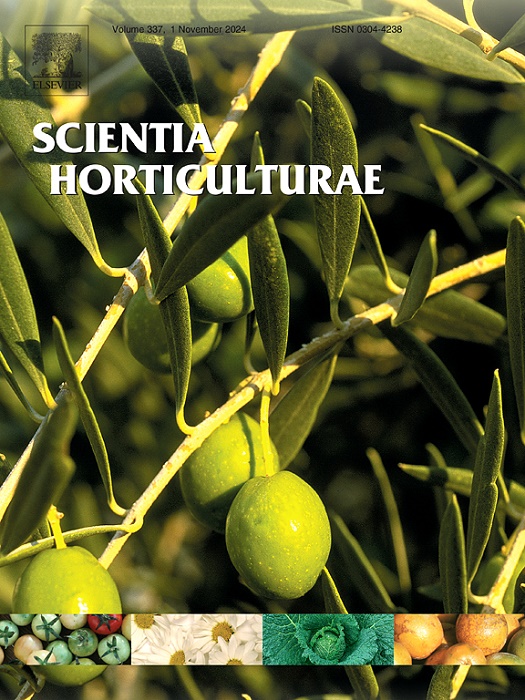联合应用高岭土和超吸水聚合物可缓解番茄植物的水分胁迫,提高产量和水分利用效率
IF 4.2
2区 农林科学
Q1 HORTICULTURE
引用次数: 0
摘要
水胁迫是严重制约伊朗农业生产力的因素之一。本实验旨在评估高岭土(KL)和超强吸水聚合物(SAP)单独或组合使用对减轻水胁迫对番茄的有害影响的效果。试验设计了两个主要因素:灌溉制度(作物蒸散量(ETc)的 100%、75% 和 50%)和田间干旱缓解处理(对照、KL、SAP 和 KL+SAP)。结果表明,水分亏缺(仅在 50% ETc 条件下)显著降低了果实总产量、水分利用效率(WUE)、相对含水量(RWC)和叶绿素含量,而提高了渗透溶质积累率、丙二醛和抗氧化酶活性。与其他处理相比,不同灌溉制度(50%、75% 和 100% ETc)下 KL+SAP 的交互作用分别提高了果实总产量的 172%、111% 和 103%。此外,在不同灌溉条件下,KL+SAP 处理的 WUE、RWC 和叶绿素含量最高,而渗透溶质积累、MDA 和 H2O2 含量最低。这表明,联合施用 KL 和 SAP 可减轻水分胁迫对番茄植株的有害影响,因此可用于提高干旱胁迫地区番茄的产量和 WUE。本文章由计算机程序翻译,如有差异,请以英文原文为准。
Co-application of kaolin and superabsorbent polymer mitigate water stress and improves yield and water use efficiency in tomato plant
Water stress is one of the factors that remarkably constrain agricultural productivity in Iran. This experiment aimed to evaluate the effect of Kaolin (KL) and Superabsorbent polymer (SAP) separately or in combination on alleviating harmful effects of water stress on tomato. A factorial experiment was designed with two main factors: irrigation regimes (100, 75 and 50 % of the crop evapotranspiration (ETc)) and drought-alleviating treatments (control, KL, SAP, and KL+SAP) under field condition. Results showed that water deficit (exclusively at 50 % ETc) significantly decreased total fruit yield, water use efficiency (WUE), relative water content (RWC), and chlorophyll content, whereas it increased the rate of osmolyte accumulation, malondialdehyde, and antioxidant enzymes activities. As compared to the other treatments, the interaction of KL+SAP at different irrigation regimes (at 50, 75, and 100 % ETc) raised total fruit yield by 172, 111, and 103 %, respectively. Furthermore, the highest WUE, RWC, and chlorophyll content and conversely the lowest osmolyte accumulation, MDA, and H2O2 content were obtained by KL+SAP treatment at different irrigations. This indicates that co-application of KL and SAP could alleviate the harmful effect of water stress on tomato plant; therefore, it can be used to improve tomato's yield and WUE in areas with drought stress.
求助全文
通过发布文献求助,成功后即可免费获取论文全文。
去求助
来源期刊

Scientia Horticulturae
农林科学-园艺
CiteScore
8.60
自引率
4.70%
发文量
796
审稿时长
47 days
期刊介绍:
Scientia Horticulturae is an international journal publishing research related to horticultural crops. Articles in the journal deal with open or protected production of vegetables, fruits, edible fungi and ornamentals under temperate, subtropical and tropical conditions. Papers in related areas (biochemistry, micropropagation, soil science, plant breeding, plant physiology, phytopathology, etc.) are considered, if they contain information of direct significance to horticulture. Papers on the technical aspects of horticulture (engineering, crop processing, storage, transport etc.) are accepted for publication only if they relate directly to the living product. In the case of plantation crops, those yielding a product that may be used fresh (e.g. tropical vegetables, citrus, bananas, and other fruits) will be considered, while those papers describing the processing of the product (e.g. rubber, tobacco, and quinine) will not. The scope of the journal includes all horticultural crops but does not include speciality crops such as, medicinal crops or forestry crops, such as bamboo. Basic molecular studies without any direct application in horticulture will not be considered for this journal.
 求助内容:
求助内容: 应助结果提醒方式:
应助结果提醒方式:


